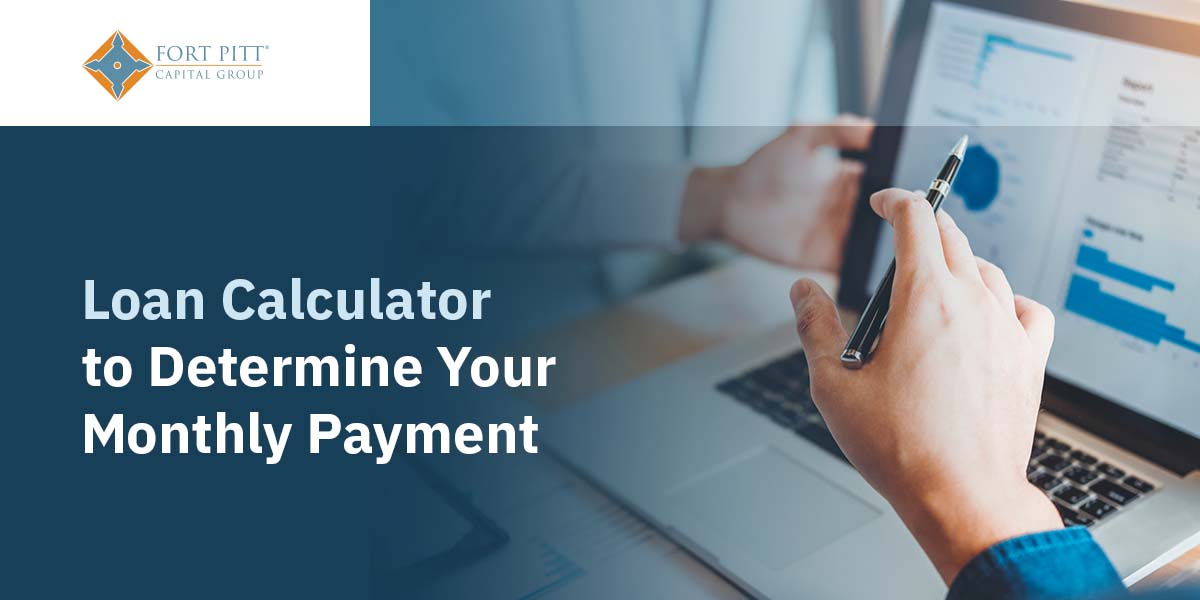
Loan Calculator
Fort Pitt Capital Group is an investment advisory firm and does not offer loans or any other banking services.
Currency and Date Conventions
Cash flow forecast...
Charts
Help
Message
Monthly Payment Calculator For Loans
Whether you’re looking to buy a house or a car or need some help paying for school, borrowing money can help you reach your goals. Before you take out any loan, it’s essential to have a clear idea of how long you’ll have to repay it and what your monthly payment will be. A loan calculator can tell you how much you’ll pay monthly based on the size of the loan, the loan or mortgage term, and the interest rate.
How to Calculate Monthly Loan Payments
Several factors influence the monthly payments you make on a loan. The amount you borrow plays a critical role in determining the size of your monthly payment. If you borrow $5,000, you’ll most likely have a lower payment than if you borrowed $10,000, assuming you borrow either amount for the same length of time.
That said, how long you have to repay the loan and the payment schedule also influences your monthly payments. For example, the payment on a $5,000 loan with a 30-month repayment term (and an interest rate of 5.50%) is $177.95. If you borrow $10,000 and take 75 months to repay it (with a 5.50% interest rate), your monthly payment will be $157.14.
Interest, or the cost of borrowing money, also affects the monthly payment. Calculating this is a bit more complicated than dividing the loan’s principal by the number of months you have to repay it. For example, $5,000 divided by 30 is $166.66, not $177.95, but added interest will increase your payments.
A lender determines interest based on several factors, such as the length of the loan and your credit history. How much you borrow can also influence the interest rate, as do market conditions. Usually, the longer the term, the higher the interest rate. A lender takes on more risk when giving a borrower more time to repay. The more time you have to repay, the more opportunities there are for you to default on it or stop making payments.
A loan payment calculator can do the math for you, but if you’d like to crunch the numbers yourself to see how much you’ll pay each month, here’s what to do:
- If your rate is 5.5%, divide 0.055 by 12 to calculate your monthly interest rate. Your monthly interest is 0.004, or .4%
- Calculate the repayment term in months. If you’re taking out a 10-year loan, the repayment term is 120 months (12*10).
- Calculate the interest over the life of the loan. Add 1 to the interest rate, then take that to the power of 120. Subtract 1 and multiply 1.004120 by 0.004. Divide this by 0.006, resulting in 95.31.
- Divide the loan amount by the interest over the life of the loan to calculate your monthly payment.
Several factors can change your monthly payment amount. If you prepay the loan, you’ll end up paying less interest over time and are likely to finish paying it off before the end of the term.
Understanding Loan Terminology
When borrowing money, it’s essential to understand the terms a lender will use so you have a clear idea of what you’re borrowing and what your repayment responsibilities are. Knowing common loan terminology also gives you a clear picture of how much a loan will cost you in the long run. Some terms to know include:
- Loan Amount: Also known as the loan principal payment, this is the amount you’re borrowing. Depending on the type of loan, it can be anywhere from a few hundred dollars to hundreds of thousands of dollars. Your income and employment status play a role in determining the size of the loan amount, as do factors such as the collateral and your credit history.
- Number of Months: The number of months refers to the loan term broken down by the total months you have to repay it. For example, you have 360 months to repay a 30-year mortgage and 60 months to repay a 5-year personal or auto loan.
- Annual Interest Rate: The annual interest rate is the amount a lender charges you for borrowing money. It’s a percentage of the total amount you’ve borrowed. Interest rates can be simple or compound. A simple interest rate is calculated based on the loan principal. A compound rate is based on the amount of the principal plus any interest that has accrued.
- Payment Method: The payment method refers to whether the lender uses the start of period or end of period to determine when your loan is due. There’s usually a slight difference in how much you pay monthly based on the payment method.
- Monthly Payment: The monthly payment is how much you need to pay every month to remain on good terms with your lender and up-to-date on your loan. While some loans charge a prepayment penalty if you pay more than the amount due each month, many don’t, meaning you are free to increase the monthly payment amount to pay the loan off sooner.
- Total Interest: The total interest is how much you’ll pay over the loan term if you make the monthly payments as agreed. One way to look at the total interest is as the total cost of borrowing money. You can make your loan cost less by paying more toward the principal each month, provided there isn’t a prepayment penalty.
- Total Principal and Interest: When you borrow $10,000, you don’t end up paying back only $10,000 if there’s interest on the loan. The total principal and interest amount are what you borrowed plus the interest charged over the loan term. Keep in mind that total principal and interest might not cover all the costs of borrowing money. Some loans have other fees, such as loan origination fees, affecting the overall cost.
How to Lower Your Monthly Loan Payment
If your monthly loan payments are more than you can comfortably afford or are interfering with other financial goals, such as saving for retirement, finding a way to reduce them may be ideal. You have several options, depending on where you are in the process.
If you haven’t yet borrowed money, you can get a lower payment by borrowing less. For example, if you’re purchasing a house or car, increasing your down payment can mean you end up with a smaller mortgage or car loan. Alternatively, you can look for homes or cars with lower prices to get a loan that better aligns with your budget.
If you already have a loan, there are several ways to reduce the monthly payment. One option is to refinance. When you refinance, you take out a new loan and use the principal from the new loan to pay off the current one. Refinancing often means getting a lower interest rate, giving you a lower monthly payment. You can also extend the loan term with a refinance, giving you more time to repay.
Similarly, you can consolidate your loans to get a lower monthly payment. For example, if you have multiple student loans with different interest rates and terms, consolidating them into a single loan can mean you pay less each month. You also get to enjoy a streamlined loan repayment as you don’t have to juggle multiple monthly payments.
Another option for student loan borrowers, particularly those with federal loans, is to see if they qualify for an income-based repayment plan. An income-based plan determines your monthly payment based on your earnings. If your payments are too high, an income-based repayment plan can give you a reprieve. However, it can also mean you end up owing more in the long run if your payments aren’t enough to cover the interest due on the loan.
In some cases, transferring a balance can mean you get a lower monthly payment. Some credit cards offer 0% rates on balance transfers, meaning you only have to worry about paying the principal due each month. If you take this route, make sure you pay the transferred balance off in full by the time the 0% offer ends.
How to Lower Your Loan Interest Rate
It’s a good idea to shop around before taking out any loan. Thorough research gives you an idea of what rates are available and helps you find the lender with the best offer. After you’ve borrowed the money and have made some payments on your loan, it’s possible to qualify for a lower rate. An improvement in your credit score or a dip in the market can mean interest rates drop.
You have a few options if you want to try and get a better rate on your loan. One popular method is to refinance, particularly if it’s a mortgage or car loan. Since mortgages often have lengthy terms, such as 15 or 30 years, it’s very likely rates will fall over your loan term.
If that happens, refinancing your mortgage means applying for a new one to get a better rate. When you refinance a mortgage, you will end up paying closing costs, much as you did when you got the first loan. Before starting the refinancing process, compare the cost of getting a new mortgage to what you’ll save over time to see if it’s worth it.
Another simple way to lower your interest rate is to see if your lender offers a discount if you sign up for automated payments. Student loan lenders often offer a slight discount, such as 0.25%, to borrowers who sign up for automatic payments.
Common Types of Loans
A loan can be either secured or unsecured. When you take out a secured loan, you put up collateral, such as a home or car. No collateral is needed to get an unsecured loan. Often, interest rates are lower on secured loans since the lender has a piece of property it can claim if a person stops paying the loan. Within those two categories are multiple loan types:
- Mortgage: A mortgage is a loan you take out to purchase property, such as your primary residence or a vacation home. You can also get a mortgage to buy an investment property, such as a rental home. Mortgage terms are most often 30 years, but shorter terms, such as 10 or 15 years, are available. A mortgage is a secured loan, as the property acts as collateral.
- Home Equity Loan: Once you have a mortgage and have made progress on it, you can qualify for a home equity loan. With a home equity loan, you borrow against your home’s equity, or paid-off value. People often use home equity loans to make improvements to their properties.
- Home Equity Line of Credit: A home equity line of credit (HELOC) also lets you borrow against your home’s equity. Instead of borrowing a lump sum and paying it off in equal installments, you borrow when and as needed, similar to how a credit card works.
- Auto Loan: An auto loan lets you buy a vehicle, such as a car or truck. Auto loans often have shorter terms than a mortgage, such as five years. Like a mortgage, auto loans are secured. The vehicle serves as collateral.
- Student Loan: A student loan pays for post-secondary education. The federal student loan program offers multiple loans depending on a student’s level and financial need. Private loans are also available. Student loans are unsecured.
- Personal Loan: A personal loan is an unsecured loan, meaning there’s no collateral behind it. You can use a personal loan for almost anything. They often have short terms, such as three or five years. Interest rates are usually higher for personal loans than for mortgages or auto loans.
Loan FAQ
Here are some answers to frequently asked questions:
- What can you use a personal loan for?: You can use a personal loan for almost anything, such as paying for a vacation, covering the cost of a medical procedure, or buying a new wardrobe.
- What’s a good annual percentage rate on a personal loan?: A good annual percentage rate (APR) on a personal loan depends on various factors, including the market and your credit history. Rates can range from 4% to nearly 36%. Usually, a rate under 10% is ideal.
- Can people with bad credit receive a loan?: You don’t have to have excellent or even good credit to get a loan. Credit-builder loans are designed for people with no credit history or low credit scores. Secured credit cards can also help you build credit. They require a deposit that acts as collateral. Some auto and personal loans are also available to people with bad credit.
- How much money should you borrow?:How much you should borrow depends on many factors, including your income, existing financial obligations, and the type of loan. Calculating your monthly payment before borrowing can help you see if a loan will work with your budget.
Talk With an Advisor at Fort Pitt Capital
Borrowing money can help you reach your financial goals, such as purchasing a home or moving up the career ladder. Using a loan calculator can show you how much you’ll pay each month and help you decide whether borrowing is the right move.
A private wealth management team can also help you achieve your financial goals. Fort Pitt Capital Group is a fiduciary, meaning we’re obligated to put your needs first and make recommendations in your best interests. To learn more, get in touch with us online.






